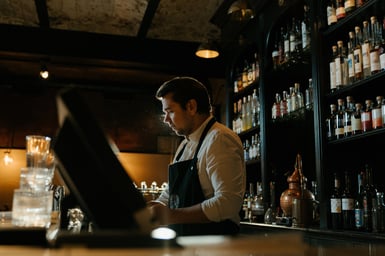 When it comes to running a successful bar, having the right inventory items and supplies is crucial. A well-stocked bar ensures smooth operations, customer satisfaction, and profitability. Let's explore some essential items and supplies that play a vital role in bar inventory systems and liquor inventory systems.
When it comes to running a successful bar, having the right inventory items and supplies is crucial. A well-stocked bar ensures smooth operations, customer satisfaction, and profitability. Let's explore some essential items and supplies that play a vital role in bar inventory systems and liquor inventory systems.
-
Liquor: The backbone of any bar, a wide selection of liquors is essential. This includes popular spirits like vodka, rum, gin, tequila, whiskey, and liqueurs. Bars should stock a variety of brands to cater to different preferences.
-
Beer and Wine: A diverse beer and wine selection is important to meet the preferences of customers. Stock popular beers, both domestic and craft, as well as a range of red, white, and sparkling wines.
-
Mixers and Garnishes: Mixers such as soda, tonic water, fruit juices, and bitters are essential for creating cocktails. Garnishes like citrus fruits, olives, cherries, and cocktail onions add the finishing touch to drinks and elevate the overall presentation.
-
Glassware: Proper glassware is vital for serving various beverages. Stock a variety of glass types, including pint glasses, wine glasses, highball glasses, martini glasses, and shot glasses. This ensures the appropriate vessel for different drinks and enhances the drinking experience.
-
Bar Tools: Equip the bar with essential tools such as shakers, jiggers, strainers, muddlers, bottle openers, bar spoons, and knives. These tools facilitate efficient drink preparation and enable bartenders to showcase their skills.
-
Cleaning Supplies: A clean bar is essential for maintaining hygiene and meeting health standards. Stock cleaning supplies like disinfectants, bar towels, sponges, brushes, and sanitizers to ensure a tidy and safe environment.
-
Inventory Management Software: To streamline bar inventory systems and liquor inventory systems, invest in inventory management software. These systems enable accurate tracking, recording, and analysis of inventory levels, helping with stock control, reordering, and preventing shortages.
-
Security Measures: Implementing security measures like surveillance cameras, liquor bottle locks, and employee training on inventory control can help prevent theft and unauthorized consumption.
-
POS System: A point-of-sale (POS) system is essential for efficient transactions and inventory management. It tracks sales, deducts items from inventory, and generates reports for better analysis and decision-making.
-
Backup Supplies: Always have backup supplies on hand for emergencies or unexpected demand spikes. This includes extra bottles of popular liquors, spare glassware, and additional stock of frequently used mixers.
In conclusion, a well-stocked bar requires essential items and supplies for effective bar inventory systems and liquor inventory systems. By carefully managing these inventory components, bars can ensure smooth operations, meet customer demands, and maximize profitability. Implementing a bar inventory system, utilizing technology like inventory management software and POS systems, and maintaining security measures all contribute to efficient inventory control and a successful bar operation.

 When it comes to conducting bar inventory, there are several effective methods that establishments can employ to ensure accurate tracking and control of their inventory, particularly in terms of "bar inventory" and "liquor inventory." Let's explore some of these methods in detail:
When it comes to conducting bar inventory, there are several effective methods that establishments can employ to ensure accurate tracking and control of their inventory, particularly in terms of "bar inventory" and "liquor inventory." Let's explore some of these methods in detail:

 There are countless reasons why one should be on top of their liquor inventory. Being in the business now for over 10 years here are the 4 most prominent points I have seen during that time.
There are countless reasons why one should be on top of their liquor inventory. Being in the business now for over 10 years here are the 4 most prominent points I have seen during that time. Social Media is not a fad and will be the way people get messages across now, and even more so in the future.
Social Media is not a fad and will be the way people get messages across now, and even more so in the future. With all the new Brands and flavors of alcohol and liquor coming out every day. We share with you The Shelf brought to you by our friends at
With all the new Brands and flavors of alcohol and liquor coming out every day. We share with you The Shelf brought to you by our friends at  In any business you always need to manage your day to day properly, but one thing you always need to consider and always work on is staying current with the latest and upcoming trends.
In any business you always need to manage your day to day properly, but one thing you always need to consider and always work on is staying current with the latest and upcoming trends. In the field of psychology there is a well known theory formulated by A.H Maslow called Maslow’s hierarchy which deals with human needs. Since as all hospitality operators, we deal with human beings, it is important we understand their psychological needs so they can better appreciate their experience at your place of business and we can assure ourselves of a satisfied customer that may return and also speak well to others about their enjoyable dining/drinking experience.
In the field of psychology there is a well known theory formulated by A.H Maslow called Maslow’s hierarchy which deals with human needs. Since as all hospitality operators, we deal with human beings, it is important we understand their psychological needs so they can better appreciate their experience at your place of business and we can assure ourselves of a satisfied customer that may return and also speak well to others about their enjoyable dining/drinking experience. s Beverage Service
s Beverage Service
